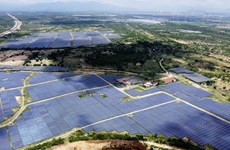2021-2025 poverty standards to help better identify poor households
In a long term, the impact of the multi-dimensional approach on the poverty standards will help better identify the poor households, on the basis of which assistance will be provided for them to sustainably get out of poverty and enjoy chances to settle the problem by themselves.
 Illustrative photo (Source: VietnamPlus)
Illustrative photo (Source: VietnamPlus)Hanoi (VNA) - In a long term, the impact of the multi-dimensional approach on the poverty standards will help better identify the poor households, on the basis of which assistance will be provided for them to sustainably get out of poverty and enjoy chances to settle the problem by themselves.
Multi-dimensional poverty standards serve as a basis for the making of policies, mechanism, and solutions to realise the goal of inclusive and sustainable poverty reduction.
To realise the goal of poverty reduction step by step, Vietnam has seven times issued national poverty standards which serve as a basis for defining the main beneficiaries of the policy. In the eighth amendment, the national multi-dimensional poverty standards for the 2021-2025 period aims to identify the poor and hear-poor households in a more accurate and comprehensive way.
On the basis of the calculation by the General Statistics Office under the Ministry of Planning and Education, the budget projection and the goal of improving the livelihood of the poor, the Ministry of Labour, Invalid and Social Affairs (MoLISA) has proposed the application of the monthly per capita income levels of 1.5 million VND (64.72 USD) for rural dwellers and 2 million for urban dwellers to be recognised as poor. Those figures mark an increase of 114.2 percent and 122.2 percent to the current levels of 700,000 VND and 900,000 VND, respectively.
The MoLISA has also forecast that by January 2021, the country will have about 16.6 percent of the total households having incomes under those poverty levels, or about 4.473 million households (2.32 million household more than the figure of 2020) with about 17.447 million people.
Basic social services include those in health care, education, housing, water for daily life and sanitary, information and job. Indices on the insufficiency of basic social services in clude nutrition, health insurance, education level of adult, schooling of children, housing quality, average per capital housing area, supply of water for daily life; toilets, use of telecommunication services, means to access information, job, and dependants.
The poor households are those having the per capita income under the minimum living standards and short of at least three indices of access to the basic social services. Meanwhile, the near-poor households are those having the per capita income under the living standards and short of less than three indices.
The households with average living levels in rural areas are those having the average monthly per capita income of from over 1.5 million VND to 2.25 million VND, and those in urban areas, from over 2 million VND to 3 million VND.
If the new multi-dimensional poverty standards are applied in the 2021-2025 period, the poor households will occupy 9.3 percent of the total, or 2.5 million households with 10 million people, while the figures for the near-poor will be about 7 percent, 1.89 million households and 7.61 million people. The total resources needed for the realisation of the national target programme on sustainable poverty reduction for the 2021-2025 will be 78.3 percent of that of the 2016-2020 period.
Clearly identifying poverty causes
The goal of standards is to objectively reflect the poverty reality of the country and serve as a basis for the working out of policies, mechanisms and solutions for the multi-dimensional, inclusive and sustainable poverty reduction.
To Duc, Chief of the National Office on Poverty Reduction under the MoLISA, said a new point this time is the one on job.
 Illustrative photo (Photo: VietnamPlus)
Illustrative photo (Photo: VietnamPlus)Multi-dimensional poverty standards will measure income and deficiency of six basic social services.
In his opinion, for the households all of whose members are the old, children, and the handicapped, it is impossible to help them get out of poverty by providing with job, but through State’s welfare policies.
For a long term, the new standards will help clearly identify the causes of poverty to help the poor get out of poverty without relying on the support from the community and the State.
Currently Vietnam is a pioneer state in the region in terms of applying multi-dimensional poverty standards, suitable to the trend of international integration, and creating a basis for the assessment of the implementation of the UN sustainable development goals to 2030./.













